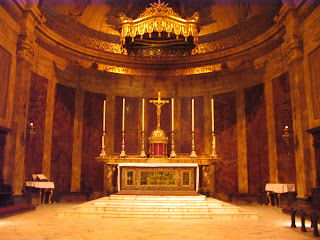STAY INFORMED
Must Watch Videos
Meaning of the Tabernacle Lamp in Catholic Churches
Two years ago, I had a terrible Friday. Many things went wrong. I drove to the local monastery to pray and spend time with Our Lord. As I entered into the abbey church, I immediately noticed that the familiar red flicker of light was missing. My heart sunk until I remembered that it was Good Friday – the one day of the year when the Eucharist is removed from the tabernacle. My subliminal shock reveals how important that little red tabernacle lamp is for us Catholics.
One of the most comforting symbols in Catholicism is the tabernacle lamp – the small red flicker of the flame burning before tabernacle – a sign that Christ is truly Emmanuel, “God among us.” In fact, you cannot even begin to understand the ending of the Evelyn Waugh’s novel Brideshead Revisited until you appreciate the profound symbolism of this little flicker before the tabernacle. The entire novel hangs upon its meaning. (By the way the recent film version of Brideshead is anti-Catholic rubbish. Don’t watch it. Just read the novel.)
In the Old Testament, God told Moses that a lamp filled with the pure oil should perpetually burn in the Tabernacle (Ex 27:20-21). This is the precedent for the Catholic Church’s custom of burning a candle (at all times) before the tabernacle – the gold house where the Eucharistic Body of Christ is reserved under lock and key.
Protestants often note that Catholic churches always seem to be open to the public, whereas Protestant congregations are typically closed throughout the week. The difference is the Holy Eucharist. Praying in a Catholic church before the Eucharist is different than praying at home. Christ is substantially present in the tabernacle. The lamp is always burning in the Catholic Church – it is a sign saying, “Christ is here in the Holy Eucharist within this tabernacle. His heart is burning with love for you.” Mystically Christ is the “true light which enlighteneth every man” (Jn 1:9).
There’s a revered custom that I hope that we can restore in our churches. Instead of a simple red lamp, there were often several lamps that hung from the ceiling of the sanctuary before the tabernacle. The traditional number for large sanctuaries was seven lamps, since it is the perfect number and represents the sevenfold perfection of the Holy Spirit.
According that zealous Doctor of the Church, Saint Alphonsus Liguori, it would be a grave sin to leave the altar of the Blessed Sacrament without this candle or lamp burning for any prolonged length of time, such as a day or several nights (St. Alph. Lig., VI, 248).
Dive Deeper

GET CONFIDENT IN YOUR FAITH
Explore the fascinating world of Catholic teachings with Dr. Marshall. Together you’ll unpack the brilliant answers the Church gives to tough questions about the Faith. The best part: you go at your own pace. Start this exciting journey today.

